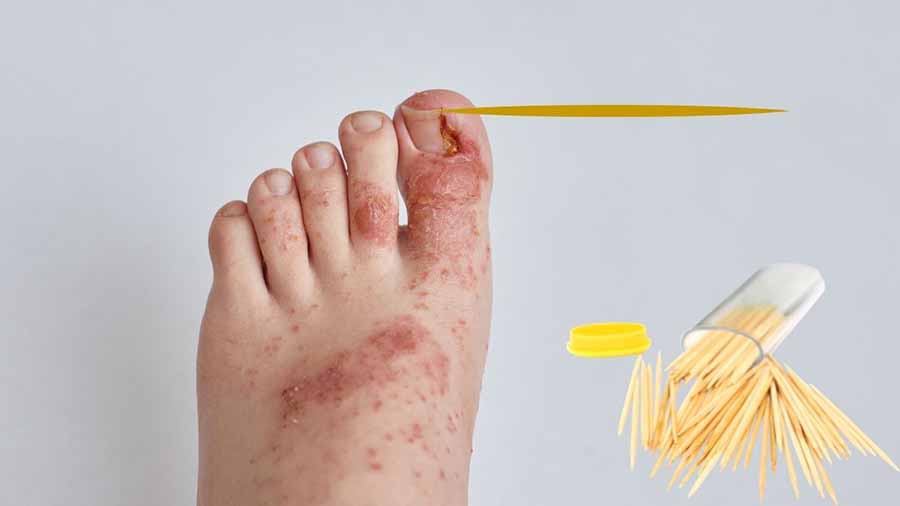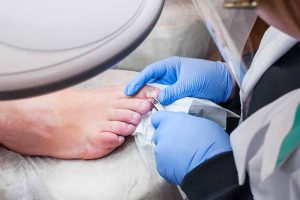Table of Contents
Overview
Ingrown toenails can be painful enough to go to the hospital immediately. Dental floss can be used as a home remedy to lift the ingrown toenail.
In the case of ingrown toenails, people want a quick remedy to get rid of the pain rather than wait or go to the hospital. Dental floss is easy to find; it can be useful to give you relief from a painful condition.
You do not need to worry about whether the dental floss is good. Doctors marked a dental floss safe to try as a home remedy for an ingrown toenail.
This article will talk about the ingrown toenails, symptoms, causes, risk factors, complications, home remedies, and treatment.
What is an Ingrown Toenail?
Ingrown toenails are very common conditions that can occur to anyone. In this condition, the corner of your toenail grows inside the soft flesh of your toe. It causes severe pain, tenderness, redness, and swelling.
An ingrown toenail usually occurs at the corners of the great toes. However, it can also affect any other toes.
Most of the time, one can take care of the ingrown toenail at home all by themselves. If the pain is severe, you may not be able to touch the toenails because of the tenderness; you should consult a doctor to get rid of it.
Ingrown toenails have some other complications, such as bleeding and bacterial infections. These complications are more dangerous than the ingrown toenail itself. So, if you are experiencing ingrown toenails for too long, you should consult a doctor soon.
Read Feet Fungus
Ingrown Toenail Symptoms
The symptoms of an internal toenail are quite similar to every people. These symptoms may include;
- Pain and tenderness
- Redness around the corner of the toenail
- Inflamed skin
- Swelling of the surrounding area
- Infections
- Bleeding from the corner of the toenail
- Green or purple discoloration of the skin
- Puss formation
- Overgrowth of skin around the toe
- Fluid accumulation in and around the affected toes
Ingrown Toenail Causes
An ingrown toenail can occur in both men and women. It can also affect people of any age. However, older people are more likely to get affected by it than younger people.
The common causes of the ingrown toenail may include;
- Wearing tight shoes
- Cutting the toenails inappropriately
- Injured toenail
- Having an unevenly shaped toenail from birth
- Feet or nail infections
- Poor postures
- Not maintaining proper feet hygiene
Ingrown Toenail Risk Factors
Anyone can be affected by an ingrown toenail. However, some people are more likely to get affected by an ingrown toenail and experience complications.
- Teenagers who do not maintain proper feet hygiene
- Using beauty products that soften the toenails
- Having a poor nail care habit that causes the nail to grow into the flesh or skin
- Cutting the nails inappropriately, such as very short or cutting the edges unevenly
- Wearing very tight shoes which constrict the toe movement and put pressure on the nails
- Participating in extreme physical sports that may cause damage to their toenails, such as football
- Having a medical condition such as Diabetes Mellitus, vascular problem in the leg, etc.
People from certain professionals are more likely to get infected by an ingrown toenail. Such as;
- Ballet dancer
- Football players
- Cricketers
- Dancers
- Kickboxers
- Heavyweight lifters
Complications
There are some complications of an end ingrown toenail ranging from mild to severe. The complications of an ingrown toenail may include;
- Infection
- Bleeding
- Gangrene
- Formation of callus
- Feet fungus infection
- Aging of the toenail
- The continuous pain, discomfort, and itching
The complications are more noticeable if you have any pre-existing medical condition such as;
- Diabetes
- Cancer
- Vascular disorders
- Infection
- Immunocompromised condition etc.
Diagnosis of Ingrown Toenail
Diagnosis of an ingrown toenail is mainly clinical. The doctor will evaluate the signs and symptoms of your condition and perform a physical examination on your feet for a provisional diagnosis.
The doctor may advise you for an X-ray to see how deep the toenail is. If the doctors suspect any infection, they may advise you for some blood tests.
Take all of your medical certificates with you while visiting the doctor’s chamber. Your pre-existing medical conditions play some important roles in the case of diagnosis and proper treatment.
Ingrown Toenail Home Remedy
Dental Floss for Ingrown Toenail
You can use dental floss to get rid of an ingrown toenail. It’s quite easy to use, and the doctors do not deny it as a home remedy if the condition is not that severe.
The steps are given below;
- Soak your feet in warm water for 20 minutes. It’ll make your toenails soft
- Sterilize the toenail and the affected area
- Take a sterile new dental floss
- Carefully insert the string of the dental floss underneath your toenail and lift it carefully
- After lifting the toenail, cut the sharp edge using a nail cutter carefully
- Use an antiseptic to clean the wounded area
Dental Pick for Ingrown Toenail
The use of dental pick is quite similar to dental floss. A dental pick contains two blunt ends that are easy to use. That’s why some people prefer dental pick rather than using dental floss.

Steps are given below;
- Soak your feet in warm water for softening the skin and nails
- Use antiseptic to sterilize the area
- Carefully use that blunt of the dental pick to lift the corner of the nail
- Carefully cut the sharp edges of the ingrown toenail
- Sterilize the area again
Cotton Ball Method
If you do not experience any infection or severe pain in the region, you may follow this method as a home remedy.
- Take a cotton ball which is soaked in olive oil
- Use the cotton ball to push the skin away from the nail edge
- Repeat the process three or four times a week
Some Other Some Remedy
- Soak feet in warm water for 15 to 20 minutes, three to four times a week
- After cutting the nails, blunt the sharp edges of your nail
- To relieve the pain, you may use over the counter pain medications such as nsaids
- To prevent infection, you must sterilize the area every time you come home from outside
Ingrown Toenail Treatment
The ingrown toenail treatment is mainly surgical. The doctor may remove the part of your nail that is penetrating the skin of your toe. After removing the part of your nail, the doctor plays a cotton gauze underneath the nail so that it cannot penetrate the skin again.
The doctor may also remove a part of your toe skin that is blocking the way of nail growth.
The doctor will use local anesthesia to numb skin and nail bed before starting the surgery, so you will not feel anything during the surgical procedure.

After the surgery, the doctor will use antiseptic to sterilize the surgical area and bandage the area to prevent infection.
You may need to keep the bandage for a few days until the surgical area is recovered.
Post-Surgical Instructions
After that surgery, you have to follow some instructions to get the best result. These are instructions may include;
- Not wearing shoes for a few days
- Avoid much movement for a few days
- Avoiding wearing socks for a few days
- Avoiding physical sports for a few days
- Applying antiseptic in the area
- Taking oral medications
- Avoiding certain foods if you are allergic to them
- Sleeping in a particular position etc.
Ingrown Toenail Surgery Result
The result of ingrown toenail surgery is noticeable within a few days after the completion of the surgery. The doctor may advise you to wear open-toe shoes to avoid further infections.
Avoiding tight socks and shoes is recommended by the doctors to maintain the result of the surgery. The doctor may prescribe some medications that delay the growth of the nails and keep the results much longer.
Your nails may grow again and unevenly, but the possibility of skin penetration is narrow.
When to See a Doctor?
You should seek a doctor if there are any following signs;
- Any sign of infection
- Bleeding
- Extreme pain
- Greenish discoloration of the area
- If you have any pre-existing medical condition such as diabetes
Ingrown Toenail Prevention
Some prevention methods may help you to prevent an ingrown toenail to some extent;
- Trim your toenails properly: Do not trim your nails unevenly. Try to trim them straight and do not keep any sharp corners. If you are not an expert in cutting your nails properly, get the help of someone to get it done
- Wear protective shoes: if you are an athlete or a dancer, wearing protective shoes can save your toenails. Ballet dancers are more prone to ingrown toenail infections. They should wear more protective shoes that do not put pressure on their toenails inappropriately during the dance or practice
- Where fit shoes: wearing loose shoes and tight shoes is both dangerous and a risk factor of ingrown toenails. Wearing fit shoes to prevent this condition.
- Maintain feet hygiene: wash your foot properly each time you reach your home from outside. If you are a water worker or work in the water for a longer period, such as swimmers, take extra precautions
- Make sure there is no infection, cracks, or wound in your feet
- If you have diabetes, use antiseptic even if there is a sign of a tiny scratch on your feet
- If your toenail is very thick, consult with your doctors.
- Avoid cutting your toenails very short; it’ll worsen the situation
Takeaway
An ingrown toenail is not every time dangerous. If there is no sign of infection, bleeding or you do not have a pre-existing condition, then you may apply some home remedy to relieve the symptoms.
Dental floss is a widely accepted home remedy for an ingrown toenail. Follow the steps carefully to get it done. If you feel discomfort or notice anything unusual while using dental floss to get rid of the ingrown toenail, consult your doctor.
Last Updated on April 6, 2022 by Learn From Doctor Team






